Photos courtesy the artist
 David Etnier’s photograph M/V Captain Neal Burgess, North Haven, 2022, offers a glowing tableau of the passenger ferry.
David Etnier’s photograph M/V Captain Neal Burgess, North Haven, 2022, offers a glowing tableau of the passenger ferry.
Early in his life as a painter, the late Stephen Etnier (1903-1984) studied privately with prominent artist-illustrator Rockwell Kent (1882-1971). Etnier’s stint with Kent helped set him on the path to becoming a celebrated artist in his own right, with gallery representation in New York City and elsewhere, and many exhibitions to his name, including the remarkable posthumous retrospective “Journeys over Water: The Paintings of Stephen Etnier” at the Portland Museum of Art in 1998.
Renowned for his bookplates, Kent designed one for his student. The small printed panel shows Etnier as a young painter, a book, a canvas, and oars tucked under his right arm, headed toward the shore. The portrait references two of Etnier’s greatest passions: painting and the sea.
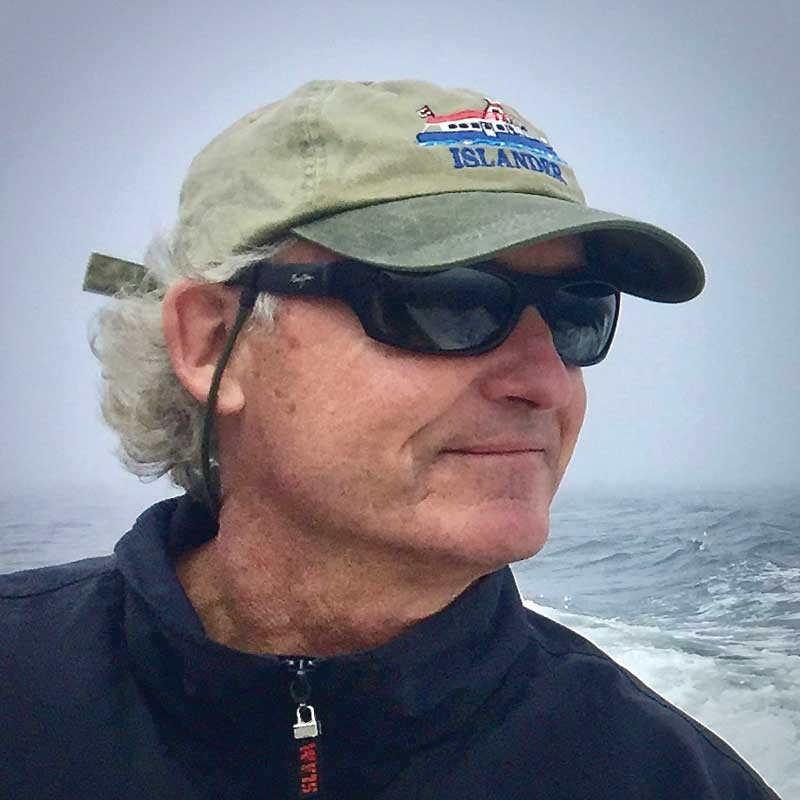 Captain David Etnier at the helm. Photo by Emma Etnier, 2017.Nearly 100 years later, another eminent painter, Joel Babb, took that Kent bookplate and revised it in honor of Etnier’s son David. In the new version, Etnier fils also walks toward the coast—the marine world of Maine is as important to him as it was to his father—but in place of the book, canvas, and oars are a backpack, tripod, and camera. You see, David Etnier is a fine art photographer with a passion for documenting the world.
Captain David Etnier at the helm. Photo by Emma Etnier, 2017.Nearly 100 years later, another eminent painter, Joel Babb, took that Kent bookplate and revised it in honor of Etnier’s son David. In the new version, Etnier fils also walks toward the coast—the marine world of Maine is as important to him as it was to his father—but in place of the book, canvas, and oars are a backpack, tripod, and camera. You see, David Etnier is a fine art photographer with a passion for documenting the world.
Over the past 50-odd years, David Etnier has created a memorable body of photographic work that includes portraits of Maine artists, coastal and island images, Portland city scenes, and deep-sea fishing pictures. His photographs are part of the Portland Museum of Art, Maine State Museum, Smithsonian Archives of American Art, and Judy Glickman Lauder collections.
Etnier began photographing Maine painters and sculptors in the 1980s, initially inspired by David Douglas Duncan’s book on Picasso, but also by artist and author portraits by Alexander Lieberman, Hans Namuth, Peter July, Rudy Burckhardt, Berenice Abbott, and others. He especially liked the photographs that showed where the individuals lived and worked. Their environments reveal as much, or perhaps more, than anything else, “what’s going on in their minds.” A framed print of Jill Krementz’s iconic portrait of E. B. White seated before a typewriter in his austere Maine studio hangs in Etnier’s home as inspiration.
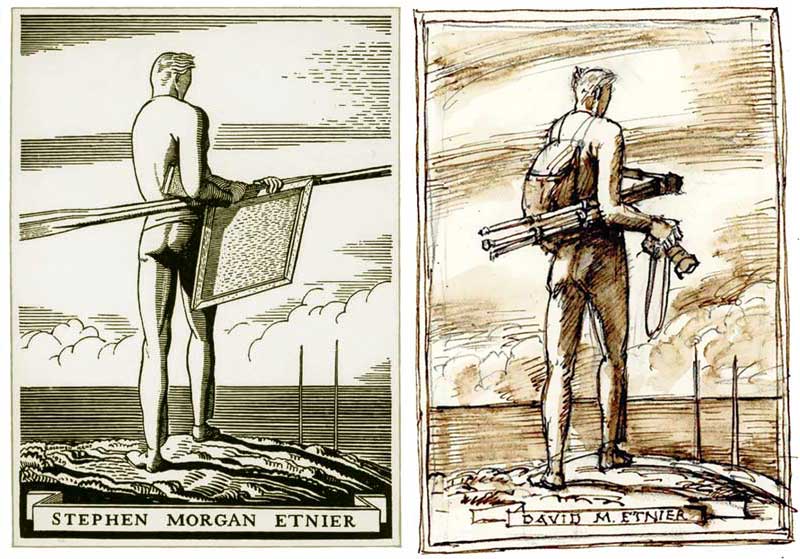 Father and son bookplates: On the left is Stephen Morgan Etnier, a relief print by Rockwell Kent, from 1929; the other, by Joel Babb, is a 2023 pen-and-ink, titled David M. Etnier.
Father and son bookplates: On the left is Stephen Morgan Etnier, a relief print by Rockwell Kent, from 1929; the other, by Joel Babb, is a 2023 pen-and-ink, titled David M. Etnier.
Etnier had photographed his father in 1983, the year before he died. Ten years later, he set up visits with artists across the state, covering several generations, from such “old masters” as John Heliker, Robert LaHotan, Chippy Chase, Cabot Lyford, Alan Gussow, Robert Solotaire, George de Lyra, William Thon, and Karl Schrag, to a group of exceptional contemporaries, among them Tom Crotty, Alan Bray, Dennis Pinette, Dozier Bell, Eric Hopkins, Katarina Weslien, Linden Frederick, Richard Estes, Brett Bigbee, and the aforementioned Babb. For many years, a selection of these portraits hung in the Portland Museum of Art.
Etnier returned to this documentary project in 2022 and 2023, encouraged by Bruce Brown, a champion of Maine photographers. He revisited some of the previous group while adding artists, including Kazumi Hoshino, Marguerite Robichaux, Jesse Salisbury, Celeste Roberge, Alison Hildreth, Charlie Hewitt, David Little, Sam Cady, Katherine Bradford, Alice Spencer, Daniel Minter, John Whalley, and Anne Neely. The series includes formal portraits of the artists as well as shots of their homes and studios. Some of them were featured in “Explorations” at Cove Street Arts and “Generations” at the Maine Art Gallery in Wiscasset last year.
Etnier recently started a new series, “Night Seen.” In one photograph, the passenger ferry M/V Captain Neal Burgess is docked at North Haven. The vessel offers a kind of light show, with its reflection in the water adding to the glowing tableau.
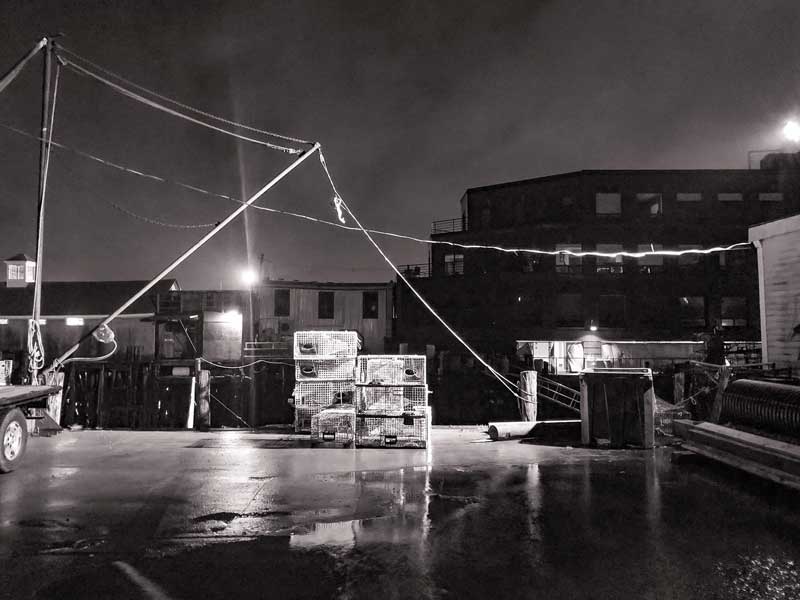 Part of David Etnier’s “Night Seen” series, Custom House Wharf, Portland, 2022, captures the city waterfront after hours.
Part of David Etnier’s “Night Seen” series, Custom House Wharf, Portland, 2022, captures the city waterfront after hours.
Another night view, of the Portland waterfront, might be a scene from a cinema noir film in which bootleggers suddenly emerge from the shadows. A stack of lobster traps takes center stage, assuring us that this is a place of commerce and seafood.
Etnier’s desire to document the world has included more distant locales, among them California, the Bahamas, Canada, Mexico, Ireland, Costa Rica, Paris, and Portugal. His heart, however, remains in his home state. His recent photographs of Frenchboro, Port Clyde, Harpswell, Phippsburg, Brunswick, and Monson, among other Maine locales, reflect his distinctive sense of place.
Tools of His Trade
Etnier began his photography career with a Pentax camera, but he soon purchased a Nikon at EP Levine in Waltham, Massachusetts, which specialized in photography equipment. Other cameras followed. He still has them, but about six years ago he switched to digital, a move he did not make without reservations; he loved the darkroom craft and disliked the way the new technology could manipulate things so easily.
Indeed, of all the photographic pursuits in the world, the one Etnier considers the most valuable to humankind is photojournalism. This belief added to his fear of digital: “If people cannot believe what they see in a photo, if they can’t bet the farm on it,” he said, “we’re going to be in trouble.”
That said, Etnier had spent a lot of time in dark rooms processing and printing, and at a certain point the romance waned. Now he is devoted to his digital camera and his printer even as he admires those photographers who continue to practice the classic techniques.
In a conversation at his home in Freeport in September, Etnier recalled when it was that he decided to pursue photography in a serious manner. He was restoring cars in his shop, Gasoline Alley, in Topsham; he believes he was working on prominent environmentalist and future Maine legislator Brownie Carson’s 1950 Lincoln convertible. Crawling around underneath the vehicle, with rust falling in his face, he said to himself, “God, I gotta stop doing this.”
Interested in photography, Etnier signed up for two courses at the Maine Photographic Workshops in Rockport in the fall of 1981. Founded by David Lyman, the school, now called Maine Media Workshops, turned 50 in 2023.
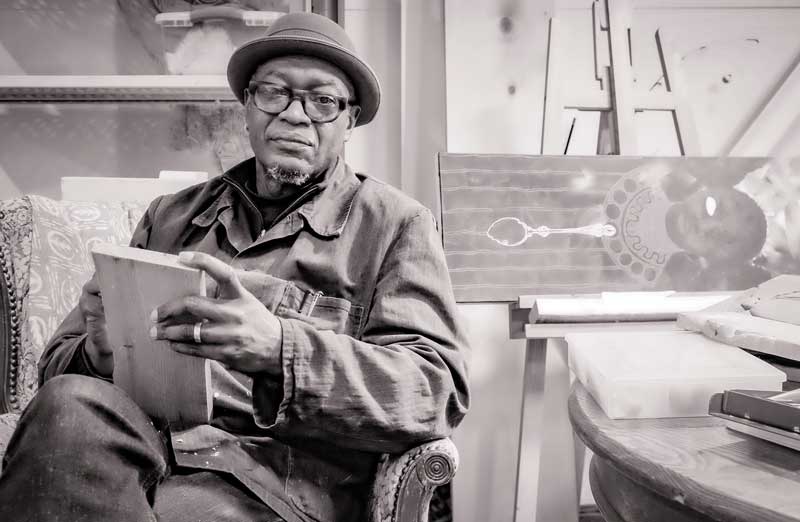 David Etnier photographed painter and children’s book illustrator Daniel Minter at the artist’s Danforth Street Studio in Portland in 2023.The courses focused on black-and-white photography. The teaching was technical—“not so much about the art of anything,” Etnier recalled—but that was fine by him and he learned a lot. He remembers some of the guest speakers, including Arnold Newman (1918-2006), Al Satterwhite, and Dick Durrance. He has a copy of the latter’s Where War Lives: A Photographic Journal of Vietnam in his library, along with many other monographs on photographers he admires and emulates.
David Etnier photographed painter and children’s book illustrator Daniel Minter at the artist’s Danforth Street Studio in Portland in 2023.The courses focused on black-and-white photography. The teaching was technical—“not so much about the art of anything,” Etnier recalled—but that was fine by him and he learned a lot. He remembers some of the guest speakers, including Arnold Newman (1918-2006), Al Satterwhite, and Dick Durrance. He has a copy of the latter’s Where War Lives: A Photographic Journal of Vietnam in his library, along with many other monographs on photographers he admires and emulates.
Etnier took his new knowledge and photographed street and waterfront scenes in Portland. The images capture people and places with an eye to atmosphere and spirit, be it “Ruthie” behind the counter at Recordland on Congress Street, the Greyhound station on St. John Street, or draggers lined up at the Custom House Wharf.
A year after the workshops, Etnier moved to Boston to pursue a career in photography. Impressed by his dramatic photographs of swordfishing boats at sea (one of them made the cover of National Fisherman), Jack Richmond took him on as an assistant in his commercial studio and soon made him manager. Etnier went on to work as a freelance assistant for other commercial photographers in the Boston area, helping set up shoots.
In 1985, Etnier returned to Maine. He established a photo business in a building he bought in Portland and in his father’s former painting studio in Old Cove in Harpswell. He pursued commercial work as well as his own photography for nearly 10 years.
Working for the Waterfront
In 1994, Etnier switched gears. Commercial photography had lost its luster and the idea of making a living as a photojournalist seemed unrealistic.
In addition to getting married and starting a family, Etnier ran for a seat in the Maine House of Representatives and won. He subsequently served four consecutive terms in Augusta. Tapping into his knowledge of the sea, he later served as deputy commissioner of Maine’s Department of Marine Resources from 2003 to 2011.
Part of Etnier’s motive to pursue public office was a real estate boom in Maine that was threatening access to working waterfronts, including Portland’s, which, he recalled, was under siege. Having lobstered as a teenager and spent time around harbors, he had a special connection to the fishing world and a desire to preserve it.
During his tenure in the legislature, Etnier proposed a constitutional amendment to allow for “current use taxation” for working waterfront properties. He credits Long Island, Maine, lobsterman Steve Train with the original idea. Train had pointed out how Maine farms received favorable tax considerations and thought fishermen deserved a similar break. (Train recently spearheaded Lobsters for Lewiston, which helped raise nearly $25,000 for victims of the mass shooting and their families.)
“Train was the impetus,” Etnier recalled, adding, “I just happened to be in the position to put pen to paper.” The amendment passed in the House and Senate but failed the required statewide vote. However, the second time around, with former State Senator Dennis Damon of Trenton sponsoring, the amendment passed.
Not long after completing his fourth term in the legislature, Etnier was appointed to his Maine Resources post by Governor John Baldacci. In that role, with help from Tim Glidden and others, he proposed the legislation that created the Working Waterfront Access Pilot Program. The program became part of the Land for Maine’s Future initiative, using bond allocations to permanently preserve eligible working waterfront properties.
Thanks to these various initiatives and policies, preservation of Maine’s working waterfront became a cause. The Island Institute took it up as an important part of its mission, and the public’s awareness of a disappearing way of life grew a thousand-fold.
After commuting from Harpswell to Augusta for 16 years, Etnier stepped away from the world of politics. Since then, he has been a boat broker, yacht finisher, and vessel captain. He worked for Strouts Point Wharf Company in South Freeport and captained an excursion boat for the Maine Maritime Museum in Bath.
With his U.S. Coast Guard Master’s license, earned in 1992, Etnier continues to captain vessels along the Maine coast. Over the years he has skippered passenger ferries servicing Chebeague, Eagle, and Bustins islands. He and his wife Laura also have a 35-foot British sloop, Lively, that they sail every August.
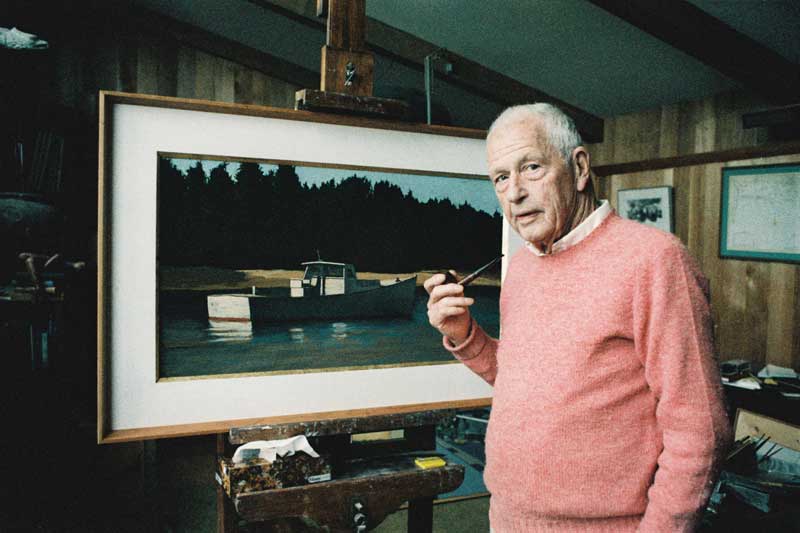 Stephen Etnier was photographed in his Harpswell studio by his brother-in-law, Robert Solotaire, in 1980. That’s one of Etnier’s classic Maine coast paintings, Ash Cove, Harpswell.
Stephen Etnier was photographed in his Harpswell studio by his brother-in-law, Robert Solotaire, in 1980. That’s one of Etnier’s classic Maine coast paintings, Ash Cove, Harpswell.
As he recommits to his photography, Etnier thinks of his father, who would get up at the crack of dawn to go painting, wanting to be in a particular spot when the light was just right. Surrounded by his paintings growing up, David credits his father with instilling in him a love of the visual and a fundamental sense of composition.
Maine’s light and its coastal milieu connect these two independent artists across the generations. Their work encompasses waterfront and wonder.
✮
Carl Little is a columnist for The Working Waterfront. He lives and writes on Mount Desert Island.
For More Information: You can find more of David Etnier’s work at davidetnierphotography.com.






